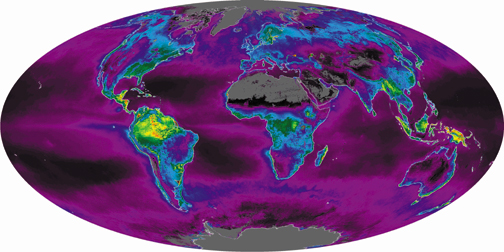
Geotimes Home | AGI Home | Information Services | Geoscience Education | Public Policy | Programs | Publications | Careers

 A new generation
of satellites is allowing scientists to, every week, watch the grass grow, literally.
Combining Moderate Resolution Imaging Spectroradiometer (MODIS) data of vegetation
density with digital data of global weather observations, they can see Earth’s
metabolism — the rate at which plants are absorbing carbon out of the atmosphere.
NASA scientists have taken this new measurement, called net primary productivity
(NPP), and created a set of animations for the 2001 and 2002 growing season.
A new generation
of satellites is allowing scientists to, every week, watch the grass grow, literally.
Combining Moderate Resolution Imaging Spectroradiometer (MODIS) data of vegetation
density with digital data of global weather observations, they can see Earth’s
metabolism — the rate at which plants are absorbing carbon out of the atmosphere.
NASA scientists have taken this new measurement, called net primary productivity
(NPP), and created a set of animations for the 2001 and 2002 growing season.  |
Geotimes Home | AGI Home | Information Services | Geoscience Education | Public Policy | Programs | Publications | Careers |